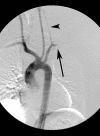Vascular injuries after blunt chest trauma: diagnosis and management
- PMID: 19751511
- PMCID: PMC2749011
- DOI: 10.1186/1757-7241-17-42
Vascular injuries after blunt chest trauma: diagnosis and management
Abstract
Background: Although relatively rare, blunt injury to thoracic great vessels is the second most common cause of trauma related death after head injury. Over the last twenty years, the paradigm for management of these devastating injuries has changed drastically. The goal of this review is to update the reader on current concepts of diagnosis and management of blunt thoracic vascular trauma.
Methods: A review of the medical literature was performed to obtain articles pertaining to both blunt injuries of the thoracic aorta and of the non-aortic great vessels in the chest. Articles were chosen based on authors' preference and clinical expertise.
Discussion: Blunt thoracic vascular injury remains highly lethal, with most victims dying prior to reaching a hospital. Those arriving in extremis require immediate intervention, which may include treatment of other associated life threatening injuries. More stable injuries can often be medically temporized in order to optimize definitive management. Endovascular techniques are being employed with increasing frequency and can often significantly simplify management in otherwise very complex patient scenarios.
Figures









References
Publication types
MeSH terms
LinkOut - more resources
Full Text Sources
Medical

